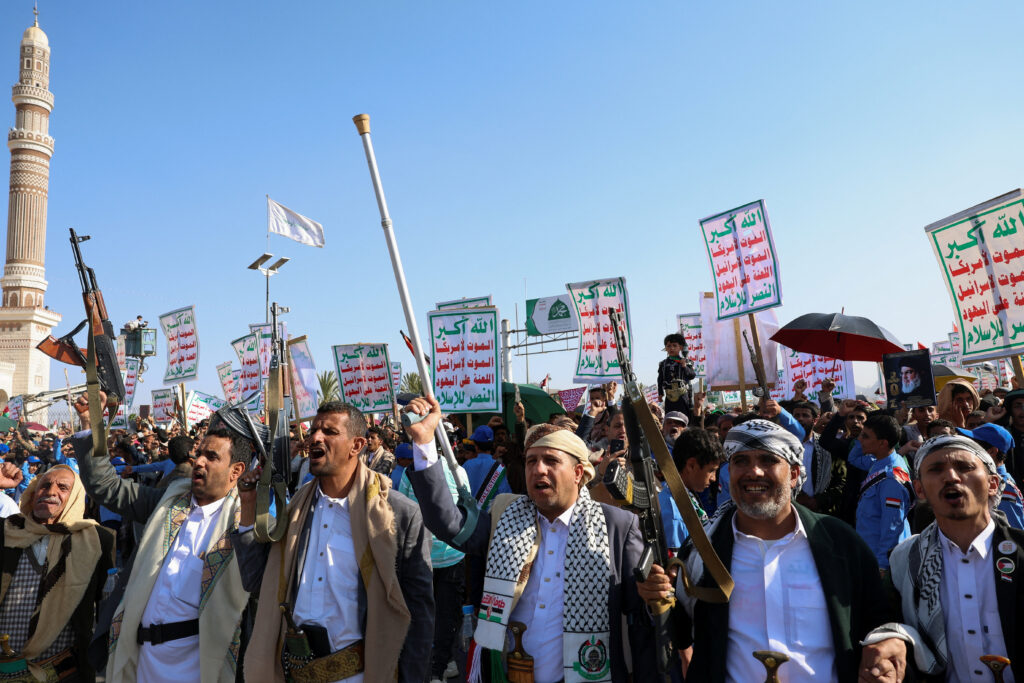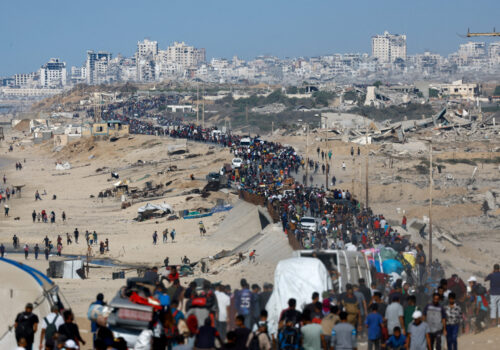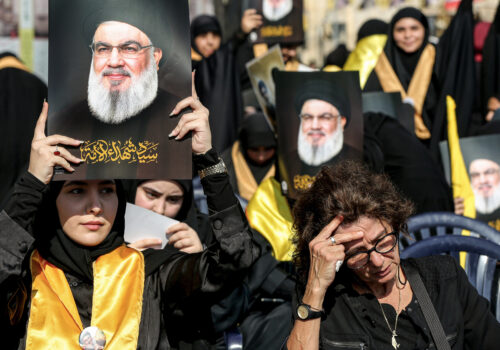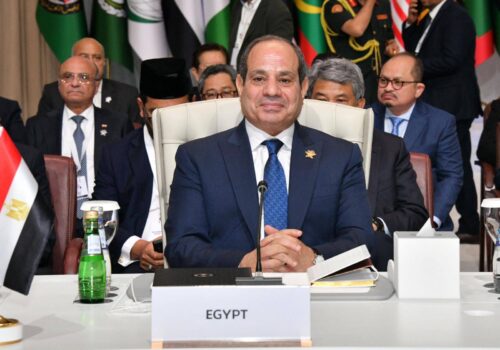Israel and Hamas consenting to a US-brokered cease-fire to end the war in Gaza is good news for the Palestinians in the strip, and provides hope that the war that increasingly drew condemnation from the international community may come to an end. However, it also raises important questions about the future direction of regional conflicts, specifically, in terms of the Houthi rebels in Yemen. The question is, how the Iran-backed group respond to this step towards peace? Will they, as they have repeatedly claimed to do, cease their hostilities in the Red Sea and their own war with Israel? The brief response is yes—but likely, only for the time being.
The Houthis were continuing to attack Israel right until the parties agreed to the Gaza cease-fire—and have since paused attacks. But the militant group seems to present this as a victory, and promise to militarily enforce Hamas’ mission if the Palestinian militant group disarms, as stipulated by the cease-fire plan. The Houthis use this commitment as proof of their dedication to the Palestinian cause, something that is deeply entrenched in their ideology and messaging as a leading force in Iran’s so-called “Axis of Resistance.” This is despite the fact of a significant military imbalance between the Houthis and Israel—felt at the expense of Yemen’s people and hopes for stability, due to colossal Israeli retaliation.
The Houthis have viewed their involvement in regional conflicts as a means to entrench their power and expand their regional influence beyond Yemen. Their attacks on Israel and hostilities in the Red Sea post-October 7 have allowed them to garner support among the Arab and Islamic worlds, build alliances with non-state actors in the Horn of Africa, and acquire support and applause from across the world. Their regional actions have also been one of their strategies to make up for their inability to deliver services and their violent behavior against Yemenis.
Even if they may claim victory over the war against Israel and cease hostilities for now, it is questionable whether they will abandon the regional gains they’ve made. They will likely continue to seek ways to secure their political and military foothold in the area.
The current “pause” may be temporary—as the Houthis remain prone to resume hostilities should they find a plausible excuse—pending their ability to find an alternative outlet to maintain their presence and influence.
Potential Houthi responses to the cease-fire
There are a few strategic pathways the Houthis could consider in their bid to maintain their post-October 7 strategic gains. Returning to domestic war is one of their options, as that serves their interests in acquiring more power internally or pressuring Saudi Arabia and the Gulf States back to the Saudi-brokered peace process.
The Houthis have been moving troops on multiple frontlines across Yemen—some of it in defense of potential government assaults. That said, a return to localized conflict could help the Houthis craft a political and humanitarian narrative towards the anger of Yemeni people and their suffering—especially as the Gaza war winds down. That gambit carries significant risks, however. The aftermath of Israeli strikes, together with the US designation of the Houthis as a foreign terrorist organization (FTO), has depleted their funding and resources and driven businesses and aid organizations out of Houthi-controlled areas amid continued harassment. As a result, this strategy could reverse their regional gains, and further worsen an already fragile economic situation.
The Houthis’ resources have been severely strained, and they are seeking ways to fill these gaps—with the Gulf being their top option. Prior to the October 7, 2023 Hamas attacks that launched the Gaza war, there was an almost-concluded cease-fire brokered by Saudi Arabia between Yemen’s internationally recognized government and the Houthis. A key component of that deal was an economic bonus where Saudi Arabia promised to fund the salaries of public and military workers in Houthi-controlled areas for one year, among other contributions. That would have injected badly needed cash into their provinces and helped soothe the mounting economic squeezes they still face.
With that agreement frozen by the Houthis during the Gaza war, they are now able to attempt to recover that lost economic advantage through coercion. By threatening neighbors’ economic infrastructure security, the group can blackmail Gulf states into reopening talks. They have previously proven that they can — namely through targeting oil installations and airports — measures that were successful in coercing Saudi Arabia into negotiations. Yet, the recent FTO designation of the Houthis makes the revival of such an agreement ever less likely.
Both options have limited strategic usefulness for the group’s primary backers in Iran, since the Houthis’ utility is in their usefulness as a regional pressure point, not necessarily as a local political force. This would also strain Iran’s delicate regional relationships, making it a less desirable course of action for Tehran at this moment.
A third option is regional re-escalation. The Houthis have always viewed regional tensions as an opportunity to expand their influence. With the December fall of Bashar al-Assad’s regime in Syria, and the significant strikes on Hezbollah in Lebanon, the Houthis have become the strongest member of the Axis of Resistance and Iran’s key ally. Tehran has for years employed indirect methods to push back against its enemies, creating chaos without overtly resorting to direct warfare. With pressure building, Iran will likely continue to do just this—utilizing the Houthis as a provocateur to lessen the pressure, and advance its own goals in the region. Their involvement underpins Iran’s broader regional interests, leveraging instability as a strategic tool of geopolitical pressure. How this will evolve remains uncertain.
The question then becomes how and why the Houthis re-engage. There are clear points of entry for the Houthis to resume hostilities in the Red Sea, or against Israel. They can easily find a pretext—or wait for a justified casus belli—to escalate. The end of the Gaza war may refocus Israel and US attention on Tehran, alongside US, United Kingdom, and European Union sanctions—which could lead Iran to counter this pressure by pushing the Houthis to resume fighting their enemies .
For Israel, the Houthi threat is distinct from the war in Gaza, and Israel believes the Houthis must pay for what they have done over the past two years. Furthermore, as Iran’s pawn, they will continue to pose a threat similar to Hezbollah and need to be eliminated, which suggests Israel does not seem to let the threat persist. Israeli Prime Minister Benjamin Netanyahu—who has long used war to pursue political interests—may find the Houthis to be a handy target for further military action. In this regard, both the Houthis and Netanyahu share one strategy in common: using war to justify their grip on power and territorial expansion. So, the resumption of wider regional conflict, at this moment, appears to be most likely.
The Houthis and Iran can define any escalation as a “response to aggression” or an effort to “lift the siege,” without getting involved in an all-out confrontation. The Red Sea will most likely be the focal point of such a contained, limited escalation—due to ease of access for the Houthis, and their demonstrated gains there post-October 7. For Iran, nudging the Houthis to resume fighting would ease outside pressure, particularly with international sanctions tightening and the possibility of Israeli attacks growing. Turning up the temperature with the Houthis would allow Iran to sustain its indirect war strategy against its foes.
To conclude, the Gaza cease-fire does not necessarily denote a complete de-escalation in the region; rather, it may be a transitional phase as various actors reposition themselves. For the Houthis, the brief hiatus on attacks against Israel and Red Sea shipping is temporary. Their standdown is not a concession—it is an unpreferable reality imposed on them. They are likely awaiting the outcome of cumulative pressures upon Iran, and moves from Israel, before they determine their next move.
While the precise direction is unclear, current readings are that the Red Sea will remain a point of contention as the Houthis and Iran seek to counter pressure from Israel, the United States, and Europe, while keeping regional tensions below the level of open conflict.
Osamah Al Rawhani is a nonresident senior fellow with the Scowcroft Middle East Security Initiative at the Atlantic Council’s Middle East Programs. He is an expert in Yemeni politics, peacebuilding, and political economy.
Further reading
Wed, Oct 15, 2025
Twenty questions (and expert answers) about the next phase of an Israel-Hamas deal
New Atlanticist By
What will follow part one of the cease-fire deal brokered by the Trump administration? Atlantic Council experts share their answers.
Fri, Oct 10, 2025
Why Lebanon is stuck in the middle on Hezbollah disarmament
MENASource By Nicholas Blanford
Lebanon finds itself caught between the rock of US pressure for Hezbollah’s disarmament and the hard place of Hezbollah refusing to do so.
Thu, Oct 9, 2025
Amid Gaza cease-fire hope, where does the Egypt-Israel relationship stand?
MENASource By Shahira Amin
Israel’s Doha strike shifted the dynamics with Cairo—stemming from concerns that Egypt may be next in Israel's crosshairs.
Image: Protesters, predominantly Houthi supporters, rally to celebrate the ceasefire between Israel and Hamas in Gaza on the day it went into effect, in Sanaa, Yemen, October 10, 2025. REUTERS/Khaled Abdullah




